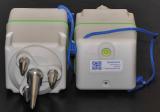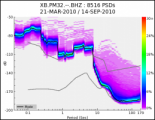
All-In-One systems combine seismic sensors with their dataloggers in a single, easily-deployed unit. Because these units do not require numerous cables to connect a sensor to its datalogger, they avoid many serious problems associated with cables, such as incorrect connector types, broken and chewed wires, or damaged pins. They are also much easier to deploy than conventional sensor/datalogger combinations. Their use can dramatically cut down on both station installation times and the number of required personnel. Their smaller size can also be very beneficial for deployments using volume-limited transportation methods, such as sea vessels.
Because Nodes and SmartSolos both utilize lithium batteries that operate above the 100Wh threshold, shipping of more than 2 units produced by either vendor will require special handling, including: packing, marking and documentation. Special handling, if needed, will require the assistance of a certified dangerous goods shipper.








